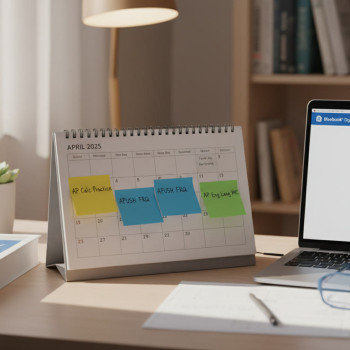Nature Breaks: Why a Walk Might Be the Best Study Tool You’re Not Using
There’s a myth that marathon study sessions and endless highlighters equal success on AP exams. The reality? Your brain needs movement, breathing room, and fresh input to turn raw study time into real learning. That’s where nature breaks — intentional, short walks outside — come in. Thoughtfully placed, they’re not distractions. They’re cognitive accelerants.

What happens in your brain during a nature walk
When you step away from a desk and walk outdoors, several beneficial processes kick in. Your prefrontal cortex — the part of your brain involved in planning, reasoning, and working memory — gets a reset. Movement increases blood flow and oxygen, which sharpens focus. Natural sights and sounds lower stress hormones, making it easier to consolidate memory. And even short bursts of walking can improve creative problem solving, so that tricky AP free-response question you’ve been circling suddenly looks more approachable.
How nature breaks help specific AP tasks
AP study isn’t monolithic. You face different demands depending on the subject: analytical reading, complex problem solving, timed essays, or data interpretation. Here’s how targeted nature breaks support these tasks.
Reading-heavy subjects (AP English Literature, AP US History, AP Seminar)
- Reset attention: After 45–60 minutes of close reading, take a 10–15 minute walk to let your working memory free up for synthesis and theme integration.
- Memory consolidation: Gentle movement after memorizing key dates or vocabulary helps cement facts into long-term memory.
- Perspective shifts: Natural settings make it easier to connect a passage’s tone or historical context to broader themes.
Problem-based subjects (AP Calculus, AP Physics, AP Chemistry)
- Incubation effect: If a problem stalls you, a short walk often leads to an “aha” moment when you return — your subconscious continues working on the problem during the break.
- Reduce cognitive load: Walking breaks prevent mental fatigue that causes silly errors in calculations.
- Active recall amplification: Combine a walk with self-quizzing aloud to test steps of an equation or reaction mechanism.
Skills and performance subjects (AP Psychology, AP Computer Science)
- Model building: Visualizing experiments or code structure during a stroll can reveal gaps or elegant simplifications.
- Stress regulation: Practice quick breathing techniques during the walk to lower test anxiety and sharpen execution during practice exams.
Designing a Nature-Break Plan That Actually Fits Your AP Schedule
Not all walks are equal. The point isn’t to wander aimlessly for an hour; it’s to structure short, intentional breaks that dovetail with your study goals. Below is a realistic, flexible framework you can adapt by subject, homework load, and proximity to AP exam dates.
A sample weekly plan
Use the study blocks to focus on one major task per block (reading, problem sets, essay practice). Insert nature breaks strategically — ideally after intense focus or before a practice exam to regulate nerves.
| Day | Study Blocks | When to Walk | Walk Length | Purpose |
|---|---|---|---|---|
| Monday | 2 × 50 min (Calc practice + review) | After first block | 10–12 min | Reset, reduce errors |
| Wednesday | 1 × 90 min (Long read: US History) | Halfway through | 12–15 min | Memory consolidation |
| Friday | 2 × 40 min (Essay practice + review) | Before essay | 8–10 min | Calm nerves, clarity of thought |
| Saturday | 3 × 60 min (Mixed subjects) | Between each block | 10–15 min | Maintain attention across subjects |
When to skip the walk
Sometimes you’ll be in a flow state — a focused streak where stopping would be counterproductive. In that case, keep going until a natural break. Conversely, if you’re exhausted or sick, prioritize rest over activity. The plan’s flexibility is what makes it sustainable.
Practical Walk Routines: What to Do on a 5–20 Minute Nature Break
Walking aimlessly can be beneficial, but pairing a clear micro-routine with the walk increases returns. Below are routines for different goals.
Routine A — The Reset (5–8 minutes)
- Walk at an easy pace away from screens.
- Breathe deeply: inhale for 4, hold for 2, exhale for 6 (three cycles).
- Scan for one small object (a leaf, a bird) and describe it aloud for sensory grounding.
Routine B — The Incubator (10–15 minutes)
- Warm-up: 2 minutes brisk walk.
- Problem incubation: silently revisit a single problem or essay prompt and imagine alternative approaches; don’t solve it — let the mind wander.
- Return: jot a single immediate insight when you’re back.
Routine C — The Active Recall Stroll (12–20 minutes)
- Bring a pocket study card or a voice memo app.
- Quiz yourself aloud on 5–8 key facts or steps (explain as if teaching someone).
- Record a 30-second voice note of a concept summary to review later.
Integrating Walks with Intense AP Prep: Timing Before and After Practice Tests
Practice exams are where strategy meets endurance. Timing your nature breaks around these simulations can make them far more productive.
Before a practice test
- Do a short 8–10 minute Reset walk to calm nerves and clear cluttered thoughts.
- Use the last 2 minutes for light breathing and a positive cue: “I know how to tackle passages and problems.”
During long test sessions (full-length practice)
In practice exams you can’t leave the room, but short mobility is possible: stand during multiple-choice sections when allowed, stretch neck and shoulders during short breaks, and use planned restroom breaks to step outside for a minute if the format permits.
After the practice test
- Take a 15–20 minute Incubator walk before diving into review. Your brain will start tagging the test’s most salient errors for easier reflection.
- When you return, prioritize reviewing the 10–15 items that felt hardest — that’s where the most learning happens.
Tools and Tiny Gear That Make Walks Study-Friendly
You don’t need much: fresh air is the core tool. Still, a few small items keep walks purposeful and friction-free.
- Comfortable shoes — stability matters for sustained walking.
- Phone with voice memo app — ideal for capturing flash insights.
- Small index cards or a pocket notebook — quick recall prompts.
- Reusable water bottle — hydration supports cognition.
- Light earbuds (optional) — for guided breathing or short recorded summaries when ambient noise is too high.
Measuring Effectiveness: Simple Metrics Students Can Use
It’s easy to assume walks help, but tracking small indicators helps you refine what actually moves the needle. Use these student-friendly metrics over a two-week trial period.
| Metric | How to Track | What Good Looks Like |
|---|---|---|
| Focus span | Record before and after study block (minutes of uninterrupted work). | Baseline + 10–20% after consistent walks. |
| Error rate | Count careless mistakes in practice problems. | Noticeable drop in simple errors within 1–2 weeks. |
| Insight frequency | Log ‘aha’ moments after walks (voice memo or note). | 2–4 useful insights per week indicates strong incubation effect. |
Real-World Examples: How Students Turned Walks Into Wins
Stories help translate theory into practice. Here are composite examples based on common student experiences.
Example 1 — Priya, AP Calculus
Priya used to sit for three-hour study marathons and burn out. When she switched to 50-minute focused blocks with 10–12 minute walks, she reported fewer arithmetic errors and clearer problem steps. Her practice test scores for free-response questions improved as she used the incubation walk to mentally rehearse solution outlines.
Example 2 — Marcus, AP US History
Marcus found long reading sessions left him fuzzy about dates and cause-effect chains. He began taking a 15-minute walk after every 60-minute reading block, using the time to verbally summarize the period’s major events. That habit turned into concise outlines he could reproduce on essays under time pressure.
How to Combine Guided Tutoring With Nature Breaks
Nature breaks complement tutoring exceptionally well. Tutoring sessions are where you get targeted feedback; walks are where you incubate that feedback into practice. For students who use Sparkl’s personalized tutoring, the rhythm can be powerful:
- After a Sparkl 1-on-1 session, take a 10–12 minute Incubator walk to mentally rehearse tutor feedback and convert it into next steps.
- Use tailored study plans from Sparkl to schedule which topics will be tackled in the next study block — then use walks to consolidate those targeted micro-goals.
- Sparkl’s expert tutors can help you design efficient active-recall prompts to use during the Active Recall Stroll.
Common Mistakes and How to Avoid Them
Even a great strategy can fail in practice. Here are pitfalls students run into — and quick fixes.
Mistake: Using walks as extended procrastination
Fix: Timebox the walk (set a simple alarm) and attach a single micro-goal to it, like recording one voice memo or naming three key facts.
Mistake: Overdoing it (too many long walks)
Fix: If walks are eating study time, shorten them or reduce frequency. The trick is quality, not length.
Mistake: Trying to memorize complex material while distracted
Fix: Use walks for consolidation and recall, not initial heavy memorization. Input first, walk later.
Putting It All Together: A 4-Week Tune-Up Plan for AP Season
Here’s a compact, practical plan you can follow in the month leading up to a major AP exam. Tailor it by swapping subject-specific practice for the placeholders below.
- Week 1 — Create baseline: Track focus span and error rate. Start 50-min blocks with 10-min Reset walks.
- Week 2 — Practice incubation: After each challenging problem set, take a 12–15 minute Incubator walk and record insights.
- Week 3 — Simulate tests: Do two full-length practice exams with pre-test Reset walks and post-test Incubator walks; adjust pacing based on metrics.
- Week 4 — Fine-tune: Use Sparkl’s personalized tutoring (if available) for targeted weak points. Integrate Active Recall Strolls and finalize quick breathing routines to use on test day.
Test-Day Tips: Mini Nature Practices You Can Do Anywhere
On the test day you may not have a trail handy, but small versions of the nature break mindset still help.
- Window gaze: Look at greenery or sky through a window for 60 seconds before the test to lower cortisol.
- Grounding breath: 4-2-6 breathing for 30–60 seconds while standing in line.
- Micro-incubation: If stuck on a question, close your eyes for 20 seconds, breathe, and visualize the problem backward (from answer to question).

Final Thoughts: Nature Breaks as a Study Philosophy, Not a Quick Hack
Nature breaks are more than a trendy productivity trick. They teach an important meta-skill: strategic disengagement. Learning isn’t only accumulation; it’s interaction between focused effort and deliberate rest. When you weave short walks into a thoughtful study plan, you harness physiology, attention, and creativity to make every minute of study count.
And if you want help designing a study schedule that uses nature breaks most effectively, consider pairing your plan with Sparkl’s personalized tutoring — expert tutors, tailored study plans, and AI-driven insights can help you make those walks work harder for your specific AP goals. Small, intentional changes like this often produce the largest gains.
Quick takeaway checklist
- Aim for 8–15 minute nature breaks after intense 45–60 minute study blocks.
- Use short routines: Reset, Incubate, or Active Recall depending on goals.
- Track simple metrics for two weeks to see improvements in focus and error rates.
- Integrate tutoring feedback into your walks to turn guidance into action.
- On test day, use window gazes and breathing to mimic nature’s calming effect.
Walks won’t replace hard work — but they will make your hard work smarter. Lace up, step outside, and let a short stroll do what hours at a desk sometimes cannot: clear the mind, reveal the answer, and turn study into insight.




















No Comments
Leave a comment Cancel